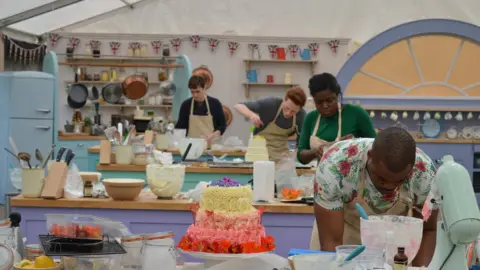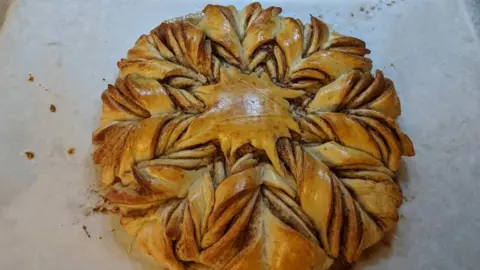Why Americans love the Great British Bake Off
 Love Productions
Love ProductionsIt's the most British of shows, yet this world of Victoria sponges and Bakewell tarts has Americans transfixed. What's the recipe for its success in the US?
It was a Bedfordshire clanger that did it.
Laura Sampson was in her farmhouse in rural Alaska, watching the Great British Bake Off (known as the Great British Baking Show), when the hosts unveiled the contestants' latest task. It was a stuffed suet pastry - half-savoury, half-sweet - a recipe long forgotten by almost everyone in the UK and certainly unknown on the other side of the Atlantic.
"For some reason, that was the bake that got me worked up. I wanted to be in the tent," she says. "That's when I decided to start my own bake-a-long."
Since September, Laura has been running a Facebook group for fans of the series based in the US.
"The Official Steamed School Pudding Thread!" is a sample post in the group, which now has more than 200 members. Laura gives tips on converting measurements in the show to the US equivalents, and then posts a weekly challenge, allowing fans across the country to come back with pictures of their creations.
At first she thought about sourcing a big prize, but then she realised this was not in keeping with the ethos. What Americans often praise about the show is the lack of cut-throat competition or monetary incentives.
Allow X content?

As the LA Times once wrote: "Contestants never say things like 'I didn't come here to make friends.' There are no irritating product placements and - perhaps most incomprehensibly to American audiences - no material riches to be won."
Incredulously, it continued: "That's right: The winner of The Great British Baking Show wins a title and an engraved cake stand, and that's it."
A tricky start
The show's introduction into American life has not been straightforward. First, the name had to change, because the Pilsbury company have trademarked "bake off". It was also shown out of sequence, via the PBS network.
And then there was the controversy of the third series of the American version - called The Great American Baking Show and running on ABC - when host Johnny Iuzzini was accused of sexual harassment and the series was pulled midway through its run. Nobody saw winner New York lawyer Vallery Lomas take her prize and she has recently been calling on the channel to air the missing episodes.
To attempt to reboot the American version, Spice Girl Emma Bunton took over as host at the end of last year, but it is the original show that has got the most attention.
In August, it was acquired by Netflix, bringing it to an even wider audience, which has been bingeing it over the winter months.
Allow X content?

Many US viewers have said that they decompress watching the show, and they like that it is the antithesis of the nation's fraught politics.
Laura says her baking group is a politics-free zone. "That was the biggest surprise for me. After the first round I felt I had truly found a place on social media that was kind," she says.
Lisa Gorski, a federally-employed microbiologist from San Francisco, can also relate. She has been baking recipes from the show while off work during the government shutdown. "I've been so inspired by the show that I've just been using my time off in the kitchen to try new things," she says. "It is a total escape."'
Allow X content?

And if you really want a sense of how people are finding solace in the show, look to former UN Human Rights chief Zeid Ra'ad al-Hussein. Last year, he gave the most unexpected twist to a hard news story, when he told Reuters that the Great British Bake Off was his release after dealing with world horrors.
"This man pulls out a soufflé just before the competition ends and the thing collapses," he said, recalling an episode. "I burst into tears and I couldn't stop."
Allow X content?

"I watch them all," says Charles Skinner, a government auditor and drag racer from Maryland, who is a member of the Facebook bake-along group. "The Great British Bake Off, the Great American Baking Show, Zumbo's Just Desserts [an Australian desserts competition]."
He likes the American version, but not as much. "It's less technical. You wouldn't get a bread lion," he says. And he was a big fan of Mary Berry, who presented the original BBC run of the show. "I would love to meet her. She seems so witty."
 Charles Skinner
Charles SkinnerHe has expanded his own kitchen repertoire through the show. "I live in a remote area and I never know if what I am making is turning out right, so that's why I like watching the judges' reactions." And that's why he joined the Facebook group.
Chrystina Cappello, an engineer from Philadelphia, also wanted to try out the show's recipes alongside others, and she decided to create her own "baking tent" atmosphere by running themed parties.
She started getting a group of friends together - those who bake and those who want to judge. "There was a score card, and the judges would deliberate and talk about why each item deserved its score in each of the categories: level of difficulty, originality, presentation, and taste," she says.
She says it was the camaraderie of the show that won her over. "The producers focus on the moments that the team are working together - when someone helps someone take something out of a pan, when someone has a suggestion on how to fix something, or just gives a much-needed hug. It's endearing, and it's exactly what the world needs right now - more feel-good television."
The original presenters - Mel Giedroyc and Sue Perkins - are often credited with helping set the tone of the show. They reportedly stormed off set during the first series, accusing a producer of trying to manufacture X-Factor-style drama when a contestant was reduced to tears over a personal issue.
"No one ever cried again," Perkins told the Telegraph. "Maybe they cry because their soufflé collapsed, but nobody's crying because someone's going 'Does this mean a lot about your grandmother?'"
 Chrystina Cappello
Chrystina CappelloThe Great British Baking Show is now part of US culture. The New York Times has run a translation guide. "Stodgy is bad, scrummy is good, gutted is bad," it explained.
Saturday Night Live has spoofed it; The Late Late Show has broadcast its staff bake-off; The Daily Show has used it to explain Brexit, calling it the Great British Break-Off.
The hosts and contestants are becoming household names.
Allow X content?

Great British Bake Off contestant Val Stones is a regular visitor to the US, but says she started to get recognised a lot more this year, after the show went up on Netflix.
The retired headteacher from Doncaster has had fans approach her while doing a charity fun run in New Jersey, during a wine tasting in New York State and at a Waffle House in Memphis, among other places.
 Love Productions
Love Productions"My husband says that as we walk through places, such as Tennessee and Kentucky, folk would give me a second glance on hearing my distinct voice, but then think they were wrong," she told the BBC. Lots of people start the conversation with "Do I know you? Do you live on my street?".
Allow X content?
And it is that neighbourly familiarity combined with an across-the-pond sweetness - which even the British find unusual - that has made it so popular.
The New York-based Fansided website recently summed up the appeal of the "cheerful little series" following a spat of difficult news worldwide.
"Nobody shared their views on Brexit or gave their opinion on Theresa May. Hardly anyone even mentioned personal hardships [...] All that outside noise, is left where it belongs - outside," it wrote.
"The Great British Baking Show," it concluded, has become "the perfect set of arms to run into".
